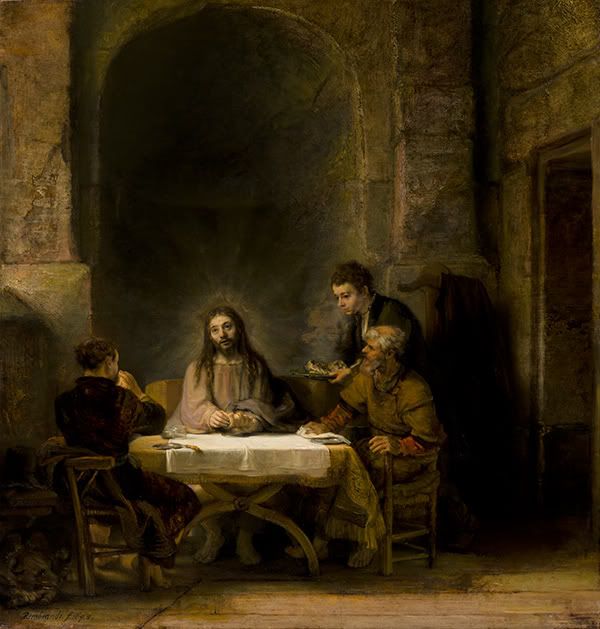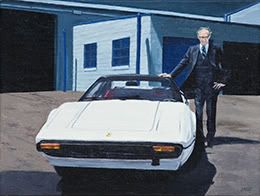|
|
Director's Letter
 | |
The law of unintended consequences came into play in a big way when we opened the loggia on the John R Street side of the building as part of the New DIA in 2007. Since the Eleanor and Edsel Ford (South) Wing opened in 1966, the primary public entry was from Farnsworth Street, with the city-owned underground parking lot conveniently located nearby. (The near-universal tendency of this country's major municipal museums adding wings to Beaux Arts buildings in the 1960s and either closing or playing down the original grand entrance is a subject I do not have space to address here.) When we made the decision to add a temporary art-storage facility to the South Wing that could subsequently be used for exhibition and education spaces, the notion emerged that the space between the addition and the entry to of the Detroit Film Theatre could be linked by some sort of protective colonnade. There would be drop-off spaces for school buses in the daytime and valet parking at evening events; an all-weather pathway would link the Education space and the Film Theatre to Prentis Court, now conceived as a gathering place, and the new catering facility adjacent to it. It seemed like--and, in fact, was--a very good idea indeed.
What we did not anticipate was the deterioration and progressive closure of the underground lot, which has required more and more of our visitors to park in the DIA's Cultural Center parking lot off John R. And if these visitors leave the parking lot via the driveway from which they entered rather than, as intended, through the gate on Farnsworth, they are confronted by the loggia, which looks amazingly like an entrance to the museum. There is no crosswalk there, but many head for the loggia and, though signage has been effective in deflecting many visitors south to what is, I hope, a warm welcome in the Farnsworth Lobby, a significant amount continue into the loggia only to be met by a security officer who directs them back outside to the "real" entrance. As you can imagine, this is not always well received.
We looked at the possibility of making the loggia a full-time entrance but for various reasons--both financial and logistical--it was not something we could take on now. One reason was the need for a crosswalk, and we had been unable to persuade those in charge of such things that DIA visitors deserved such an amenity. The opening of the University Prep charter school at the Science Center, however, changed things, and a crosswalk with a stop light has been installed at Farnsworth. We intend to reorient the Cultural Center lot so that cars enter from Brush Street and exit on Farnsworth (a two-way street). Once parked, visitors will be directed to the Farnsworth exit and the safety of the new crosswalk, which will take them right to the newly redesigned Farnsworth Lobby entrance. We had hoped to have this work completed before the onset of winter and the opening of the Rembrandt exhibition, but for all those "construction" reasons this may not happen until next spring.
As part of our cost reductions of two years ago, we reluctantly decided to close the Woodward entrance, as it is used by visitors much less than the Farnsworth one. A permanently closed front door has an unhappy symbolism, and I am happy to say that, thanks to cost savings elsewhere, we will be reopening the Woodward entrance. I hope it stays that way, but these are unprecedentedly challenging times, and we may be forced to weigh symbolism against operating costs again.

Graham W. J. Beal
Back to top |
|

Exhibitions
 Rembrandt and the Face of Jesus Rembrandt and the Face of Jesus
November 20, 2011-February 12, 2012
Special Exhibition Galleries: South
Rembrandt van Rijn was hailed even in his lifetime as one of the most extraordinary creative geniuses of the European artistic tradition. He dramatically changed the approach to depicting the figure of Jesus, moving away from one of majesty, drama, and theatricality to a more human one of meditation and reflection. Rembrandt was the first artist to paint Jesus as a Jew, using models from Amsterdam's Jewish neighborhood where he lived.
The approximately sixty small, intimate paintings, drawings, and prints in this exhibition cover every phase of Rembrandt's artistic exploration of the subject, from rapid sketches that were ideas for future pictures to the Louvre's masterful Supper at Emmaus, which has not been shown in the United States since 1936. A fully illustrated catalogue accompanies the exhibition, available in the museum shops.
Member preview days are Friday, November 18, from 10 a.m. to 10 p.m., and Saturday, November 19, from 10 a.m. to 5 p.m. Members-only lectures by the exhibition curator George Keyes are scheduled for 6 p.m. Friday and 1 p.m. Saturday. Members see the exhibition free, but complimentary reserved, timed tickets are necessary, available at the DIA Box Office, online at www.dia.org, or by calling 1.866.DIA.TIXS (866.342.8497). Remember, there is no handling or service fee when ordering members' tickets. For more information, call the Membership HelpLine at 313.833.7971.
The exhition opens to the general public on Sunday, November 20. Timed tickets for the exhibition are $16 for adults and $8 for youth ages 6 to 17.
This exhibition has been organized by the Detroit Institute of Arts, the Musée du Louvre, and the Philadelphia Museum of Art. In Detroit, the exhibition is generously supported by The Cracchiolo Family. Additional support has been provided by the City of Detroit.
This exhibition is supported by an indemnity from the Federal Council on the Arts and the Humanities.
Above: Rembrandt van Rijn, Dutch; The Supper at Emmaus, 1648; oil on mahogany panel. Musée du Louvre, Paris
Back to top
 Detroit Revealed Detroit Revealed
Photographs, 2000-2010
Through April 8, 2012
Albert and Peggy de Salle Gallery of Photography
 | | |
Scott Hocking, American; Baby Palms, Spring from The Zone, 2009 (printed 2010); pigment print. Museum Purchase, Coville Photographic Fund
| |
The pictures in this exhibition tell stories of particular times and places in Detroit as captured by eight photographers. These stories go beyond the widely circulated images of the city's empty buildings and give visibility to the vibrant, often surprising culture of the city and its people. It's not that the exhibition ignores the city's dark side, but rather it contains contradictions: photographs of carefully tended gardens and vacant lots verging on prairies; the Ford Rouge Plant humming with activity and the eerily empty corridor of the complex's Rolling Hall.
Scott Hocking captures the return of some of Detroit neighborhoods to a state of nature (left). Carlos Diaz spent the summer of 2010 on Detroit's southwest side, in Mexican Town, walking through neighborhoods photographing homes with cared for gardens and religious shrines, a slice of Detroit life unknown to those outside the city.
Andrew Moore's work focuses on abandoned and obsolete factory interiors, while Michelle Andonian looks at functioning plants and their workers. But her images present their own contradictions. She documented the last days of production on Ford Motor Company's Mustang assembly lines as the facility was changing to cleaner, greener technologies offering improved working conditions while also making older jobs obsolete.
To listen to an interview with exhibition curator Nancy Barr and photographer Carlos Diaz, click here.
This exhibition has been organized by the Detroit Institute of Arts. Support has been provided by Quicken Loans and Team Detroit. Additional support has been provided by the City of Detroit. Support for the catalogue has been provided by Furthermore: a program of the J. M. Kaplan Fund.
Back to top
 Gift of a Lifetime Gift of a Lifetime
The James Pearson Duffy Collection
Through March 18, 2012
Special Exhibitions Central
 | | |
Ann Mikolowski, American, 1940-99; James Duffy, 1982; oil on canvas. Bequest of James Pearson Duffy © 2011 Estate of Ann Mikolowski, courtesy of Ken Mikolowski
| |
James Duffy went beyond collecting contemporary art; he became a friend to many of Detroit's Cass Corridor artists whose work he bought. "How many people know a real artist," he once exclaimed. It was a two-way street; artists gained not only financially but were provided with what friend and artist John Egner called an indelible morale boost: "Most of us had never sold a picture, and here comes a guy who buys three, four, or five pictures at one time; a guy who writes good checks on the spot; but even better, a guy who calls you up or writes a note to tell you how profoundly your work has affected him."
Egner, who had been teaching at Wayne State University, accompanied Duffy on excursions to New York galleries and the studios of up-and-coming artists in the early 1970s. Duffy approached these visits with no preconceived notions and continued to make bold choices. His purchase of three paintings by Elizabeth Murray may have been the earliest sales made by the artist, who would become so celebrated in the following years. Duffy's acquisition of Philip Guston's Driver, the first work sold from a new series of unpopular figurative works, was made years in advance of the adulation subsequently heaped upon the artist for his nonabstract images.
Egner's friendship with Duffy continued well past these buying trips, as indicated by an inscription from the artist and his family on the back of a 1993 drawing: "Dear Jim, Like most big birthdays this one is worse in anticipation than in fact. You'll feel no worse or older tomorrow than you felt yesterday. We'll still love you! All the best, John, Linda, & Julianna." The occasion was Duffy's seventieth birthday.
Back to top |
|
Detroit Film Theatre
The DFT finishes up the Fall 2011 season with World on a Wire and Mysteries of Lisbon on the weekends of November 18 and November 25, respectively. The rarely screened World on a Wire is German director Rainer Werner Fassbinder's gloriously cracked, boundlessly inventive take on future paranoia. With dashes of Kubrick, Vonnegut, and Philip K. Dick--yet casting a unique spell of his own--Fassbinder tells the sprawling tale of a reluctant action hero: a cybernetics engineer who uncovers a massive corporate and governmental conspiracy that threatens the entire notion of reality, thereby anticipating both Blade Runner and The Matrix in the process.
 | |
Set in the nineteenth century, Mysteries of Lisbon (left) follows a jealous countess, a wealthy businessman, and a young orphaned boy across Portugal, France, Italy, and Brazil. These are but a few of the many characters who populate Raúl Ruiz's teeming, breathtaking adaptation of one of the masterworks of Portuguese literature. Nothing is as it seems in this vast tapestry of stories within stories within stories, filmed with gorgeous period design, supremely fluid camerawork, and a wonderfully talented French and Portuguese cast.
The DFT Winter 2012 begins January 13.
For the complete DFT schedule, call the theater box office at 313.833.3237 or click here. Back to top |
|
Holiday Family Fun
The holiday season gets under way during the Thanksgiving weekend and continues through New Year's Eve. The museum is closed Thursday, November 24, for Thanksgiving, but is back in action on Friday, November 25, with special puppet shows and an additional art-making workshop, along with the regular Friday Night Live programming.
The National Marionette Theater presents a faithful retelling of Pinocchio, the childhood favorite about the little wooden puppet that longs to be a real live boy, on Friday, November 25, Saturday, November 26, and Sunday, November 27, at 2 p.m. The puppet mania continues with the weekend's drop-in workshops, featuring different puppet types each time, including an extra workshop on Friday afternoon from noon to 4 p.m. And don't forget to check the marionettes from the DIA's extensive puppet collection on view in the cases near the Lecture Hall.
Saturday, December 3, is the Cultural Center's annual Noel Night, when more than sixty area venues, including the DIA, open their doors to the public free of charge for an evening of music and merriment. The DIA stays open until 9 p.m.
Look for Hanukkah, Christmas, and Kwanzaa storytelling performances on successive Sundays at 2 p.m., beginning with Hanukkah on December 4. The DIA is closed on Christmas Day, December 25, and New Year's Day, January 1, but open the entire week between the holidays with more puppet-making workshops and two new puppet shows.
To check on all the holiday events, check the DIA website.
Back to top |
|
 Read All About It Read All About It
Interested in learning more about the art in current exhibitions? There's plenty of reading material available in the museum shop for Rembrandt and the Face of Jesus, Detroit Revealed, and Gift of a Lifetime: The James Pearson Duffy Collection.
The fully illustrated Detroit Revealed: Photographs, 2000-2010 includes essays by Nancy W. Barr, John Gallagher, and Carlos McCormick examining the subjects and history common to photographic activity in Detroit and the emergence of new narratives and artistic practice that reveal the city as an honest and illuminating indicator of contemporary American experience. Price: $34.99; $31.49 for members.
Rembrandt and the Face of Jesus is accompanied by a lavishly illustrated book bringing together paintings, etchings, and drawings from the exhibition along with commentary by noted scholars in the field. Among the essays is one by exhibition curator and DIA Curator Emeritus of European Paintings George Keyes. The catalogue is available in hard and soft cover, $65 (members $58.50) and $45 (members $40.50).
The latest issue of the Bulletin of the Detroit Institute of Arts contains two articles related to Gift of a Lifetime: The James Pearson Duffy Collection: an appraisal of Duffy as a collector by exhibition curator Mark Rosenthal and an examination of specific works by independent scholar Dennis Nawrocki. Also in the Bulletin are articles on John Sloan's Wake of the Ferry, James McNeill Whistler's Violet and Blue: Among the Rollers, and the three masterpieces in the collection by Yorban artist Olówè of Isè. Price: $15, $13.50 for members.
Back to top |
|
|
|
|
Le Carnaval des ArtStars Gala
There's still time to purchase tickets for the DIA's annual gala benefit that this year transforms the museum into a European carnaval. Spaces are available for the November 12 evening with dinner or the late Night Rider portion featuring cocktails and creative confections, beginning at 9:30 p.m. All proceeds from the event support museum programming, including exhibitions, lectures, performances, student tours, community outreach, and much more.
To purchase ArtStars gala tickets, call 313.833.7967. Back to top |
|
|
Detroit Institute of Arts
5200 Woodward Avenue
Detroit, Michigan 48202
www.dia.org
313.833.7900
Comments or questions about the newsletter? Please contact us: comments@dia.org
ADMISSION
$8 adults, $6 seniors, $4 children
The museum is free for members
Contact the Membership HelpLine at
313.833.7971 or membership@dia.org
For group sales (15 or more) contact 313.833.1292 or dia.org/grouptours
CATERING & RENTALS
Call 313.833.1925 or
catering@dia.org
|
HOURS
Museum
Mon, Tue CLOSED
Wed, Thur 10 a.m.-4 p.m.
Fri 10 a.m.-10 p.m.
Sat, Sun 10 a.m.-5 p.m.
PARKING
Valet parking is available at the Farnsworth entrance on Fridays, Saturdays, and Sundays, during regular museum hours. The price per car is $8.
Lighted, secure self-parking is available in the Cultural Center parking lot, between John R and Brush, behind the museum.
Ford Free Second Sundays are generously supported by the Ford Motor Company Fund.
|
CaféDIA
313.833.7966
Wed, Thur 11:30 a.m.-2:30 p.m.
Fri 11:30 a.m.-2:30 p.m., 5-9 p.m.
Sat, Sun 11:30 a.m.-3 p.m.
Kresge Court Coffee Stop
Wed, Thur 10 a.m.-3 p.m.
Fri-Sun 10 a.m.-4 p.m.
Museum Shop
313.833.7944
Open during museum hours
|
|
|
|
|
|